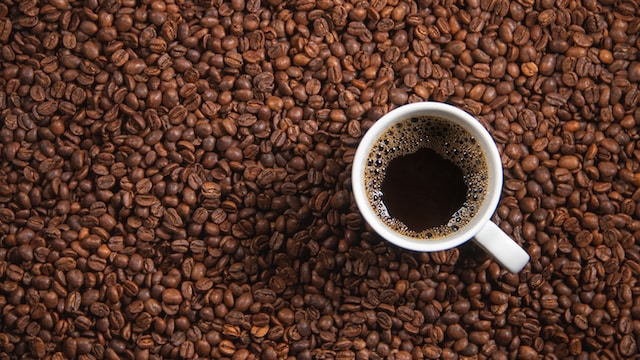Brief introduction to the world of coffee
Coffee, the magical elixir that powers our mornings and fuels our afternoons, comes in a multitude of forms. From frothy lattes to creamy cappuccinos, the coffee world is vast and diverse. At its core, however, are two basic styles: black coffee and Americano.
Definition and background of black coffee
Black coffee is simply coffee brewed without any added milk, cream, or sugar. It can be made using various brewing methods, such as drip, pour-over, or French press, and is enjoyed by millions of people worldwide.
Definition and background of Americano
Americano, on the other hand, is an espresso-based drink consisting of a shot or two of espresso diluted with hot water. It was supposedly created by American soldiers stationed in Europe during World War II who were looking for a milder and more familiar coffee taste.

Composition and preparation
1. Black coffee
a. Brewing methods
Black coffee can be prepared using various methods, including drip, pour-over, French press, AeroPress, and even Turkish coffee. Each method imparts a unique flavor and texture to the final cup, making black coffee a versatile and customizable beverage.
b. Bean selection and grind
The choice of coffee beans and grind size can greatly impact the taste of black coffee. Beans from different regions offer distinct flavor profiles, while the grind size influences extraction, with coarser grinds typically producing a lighter, more acidic taste, and finer grinds yielding a bolder, richer flavor.
c. Water-to-coffee ratio
The water-to-coffee ratio also plays a crucial role in the taste of black coffee. A standard ratio is approximately 15:1 (water to coffee), but this can be adjusted to suit personal preferences, with a higher ratio yielding a weaker cup and a lower ratio producing a stronger, more concentrated brew.

2. Americano
a. Espresso extraction
The base of an Americano is espresso, which is made by forcing hot water through finely-ground coffee under high pressure. The result is a small, concentrated shot with a bold and intense flavor profile.
b. Hot water addition
To create an Americano, hot water is added to the espresso, diluting it and creating a milder, smoother taste. The ratio of water to espresso can be adjusted to achieve the desired strength and flavor.
c. Variations: long black and iced Americano
There are variations of the Americano, such as the long black, which is made by pouring espresso over hot water, preserving the crema and creating a slightly different taste. An iced Americano is simply an Americano served over ice for a refreshing, cold beverage.

Taste and flavor profiles
1. Black coffee
a. Factors affecting taste
The taste of black coffee can be influenced by several factors, including the brewing method, bean selection, grind size, and water-to-coffee ratio. Additionally, the freshness of the beans, water quality, and brewing temperature can impact the final flavor.
b. Typical flavor notes
Depending on the factors mentioned above, black coffee can exhibit a wide range of flavor notes. These may include fruity, floral, earthy, nutty, or chocolaty flavors, among others. The acidity, body, and finish of black coffee also vary depending on the beans and brewing method used.
c. Strength and caffeine content
Black coffee’s strength depends on the brewing method, bean selection, and water-to-coffee ratio. Generally, drip coffee and French press yield a milder cup, while AeroPress and Turkish coffee produce a stronger, more concentrated brew. The caffeine content in black coffee also varies, with an average 8-ounce cup containing between 80 to 100 milligrams of caffeine.
2. Americano
a. Espresso’s impact on flavor
The espresso base of an Americano imparts a bold, rich flavor with a hint of natural sweetness. However, the addition of hot water mellows the intensity, resulting in a smoother, more balanced cup.
b. Dilution effect on taste
The amount of hot water added to an Americano directly affects its taste. A greater quantity of water creates a milder, lighter beverage, while less water produces a stronger, more concentrated flavor.
c. Strength and caffeine content comparison
Compared to black coffee, an Americano tends to have a similar or slightly higher caffeine content due to its espresso base. An 8-ounce Americano typically contains 85 to 130 milligrams of caffeine, depending on the number of espresso shots used.
Cultural and historical context

Black coffee
a. Global consumption patterns
Black coffee has been consumed around the world for centuries, with each region putting its unique spin on the brewing process. From the Ethiopian coffee ceremony to the Italian espresso bars, black coffee has a long and storied history across various cultures.
b. Traditional coffee ceremonies
In many cultures, the preparation and consumption of black coffee are steeped in tradition. For example, the Ethiopian coffee ceremony involves roasting green coffee beans, grinding them by hand, and brewing the coffee in a clay pot called a jebena. The ceremony is a social event, symbolizing hospitality and community.
c. Influence on modern coffee culture
Black coffee has significantly influenced modern coffee culture, with third-wave coffee shops emphasizing the importance of bean origin, roast profiles, and brewing techniques. This focus on quality and craftsmanship has elevated black coffee from a simple morning pick-me-up to a gourmet experience.
Americano

a. Origin and spread
The Americano is believed to have originated during World War II, when American soldiers stationed in Italy found the local espresso too strong for their taste. By diluting the espresso with hot water, they created a beverage that resembled the black coffee they were accustomed to. This new drink spread across Europe and eventually gained popularity in the United States and beyond.
b. Relationship to World War II
The Americano’s connection to World War II highlights the cultural exchange that occurs during times of conflict. Soldiers brought their newfound appreciation for this coffee style back to the United States, influencing the growth of espresso-based drinks in American coffee culture.
c. Role in contemporary coffee culture
Today, the Americano is a staple in coffee shops worldwide, offering a more approachable alternative to straight espresso. It has also inspired countless variations, such as the long black and iced Americano, demonstrating its versatility and enduring appeal.
Conclusion
Summary of key differences and similarities
In conclusion, black coffee and Americano are two distinct coffee styles with unique characteristics. While both beverages are rooted in the simple combination of coffee and water, they differ in their preparation methods, flavor profiles, and cultural context.
Personal preference and versatility of each beverage
Ultimately, the choice between black coffee and Americano comes down to personal preference. Both beverages offer a range of flavors and strengths, making them versatile options for coffee lovers of all tastes.

The importance of understanding individual tastes and preferences
As with any culinary experience, understanding individual tastes and preferences is essential when exploring the world of coffee. Experimenting with different brewing methods, bean selections, and ratios can help uncover the perfect cup, whether it be black coffee or an Americano.
The role of black coffee and Americano in the broader coffee culture
Black coffee and Americano both play significant roles in the broader coffee culture. They showcase the diversity of flavors and preparations available within the coffee world and have inspired countless innovations in brewing techniques, coffee shop menus, and at-home coffee experiences.
So, whether you’re a devoted black coffee enthusiast or an Americano aficionado, there’s no denying the unique allure of these two classic beverages. As you sip your next cup, take a moment to appreciate the rich history, cultural significance, and craftsmanship that have made these simple yet flavorful drinks a beloved part of our daily routines.

While this article has delved into the unique characteristics and histories of black coffee and Americano, it is essential to recognize that they are just two among countless other coffee styles and variations. Coffee culture continues to evolve as enthusiasts, baristas, and roasters experiment with new techniques, blends, and recipes, giving rise to an ever-expanding universe of caffeinated delights.
As we further explore the world of coffee, we can appreciate the role that black coffee and Americano have played in shaping the industry and fostering a sense of community among coffee lovers. They have brought people together, transcending geographical and cultural boundaries, and sparking conversations, friendships, and even business ideas.
In today’s fast-paced, globalized world, coffee has become more than just a beverage; it is a symbol of connection, a shared experience that unites us in our love for its rich aroma, bold flavors, and invigorating effects. As we continue to experiment and discover new ways to enjoy this age-old elixir, we carry on a tradition that has been passed down through generations, ensuring that the magic of coffee endures.
So, the next time you find yourself debating between a classic black coffee or a smooth Americano, remember that the choice is more than just a matter of taste. It is a celebration of the diversity, history, and passion that fuels the ever-growing coffee culture. Embrace the journey, savor each sip, and let the power of coffee transport you to new worlds of flavor and imagination.







